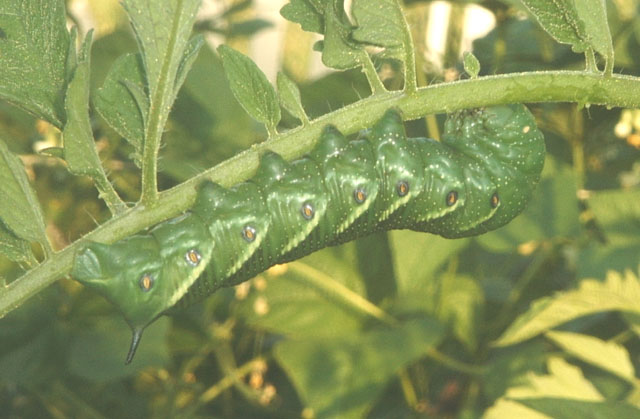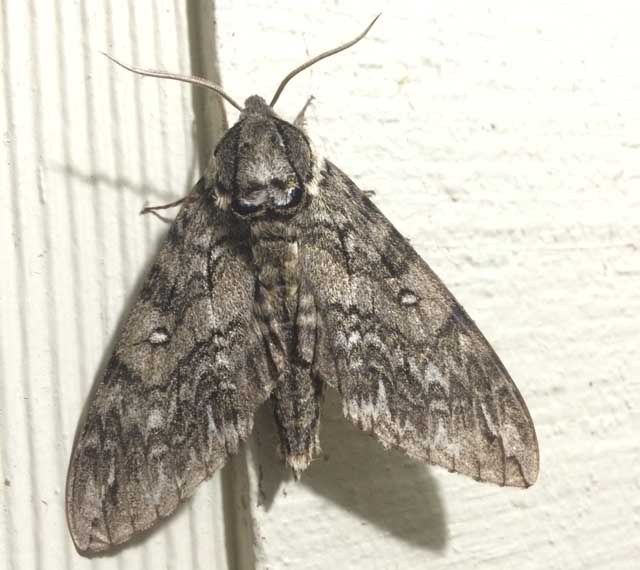Sphingini tribe:
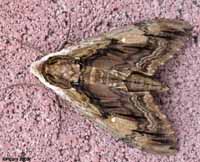 |
Ceratomia amyntor
WO/IM,
the Elm Sphinx or Four-horned Sphinx:
The upperside of the forewing is brown with dark brown and white
markings including a white costal area near the wing base, dark
streaks along the veins, and a white spot in the cell.
Elm (Ulmus), birch (Betula), basswood (Tilia), and
cherry (Prunus).
|
Ceratomia amyntor larva, August 22, 2008, on birch, Ian Miller
Ceratomia amyntor adult, June 4, June-July, 2012, Ian Miller
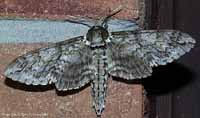 |
The upperside of the forewing is pale brownish gray with wavy black
and white lines and a black-outlined white cell spot.
|
Ceratomia undulosa, May 24, 2011, courtesy of Ian Miller.
Ceratomia undulosa, June 4, 2012, June-July 2012, Ian Miller
Ceratomia undulosa, July 19, 2015, Michael Koski
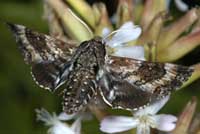 |
Dolba hyloeus
LSSS/IM, the Pawpaw Sphinx
The upperside of the forewing is dark brown with a dusting of
white scales. Some moths have patches of reddish or yellowish
brown on the wings.
Larve are not limited to pawpaw.
|
Dolba hyloeus, July 23, 2012, Ian Miller
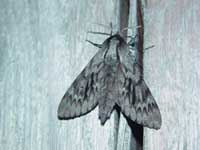 |
Lapara bombycoides
WO/IM,
Northern Pine Sphinx:
This species is now officially reported from Eau Claire.
If you have pines, you
probably have this species. It also flies on P.E.I.
|
Lapara bombycoides, May 4, 2012, Ian Miller
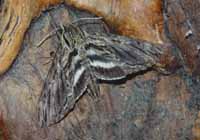 |
Generally this species is not widely reported.
Larval hosts are various species of beebalm (Monarda), mints (Mentha), bugleweed (Lycopis),
and sage (Salvia). |
Linteria eremitus, August 27-September, Ian Miller
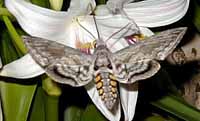 |
Manduca quinquemaculatus
Tracy Henn/Ian Miller, the Five-spotted Hawkmoth
This large bodied moth flies in tobacco fields and vegetable gardens
(potatoes, tomatoes) and wherever host plants are found. |
Manduca quinquemaculatus, August 16, 2009, Ian Miller
Manduca quinquemaculatus, June 4-September, 2012, Ian Miller
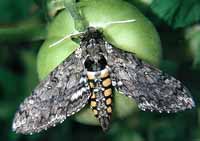 |
Manduca sexta
IM, the Carolina Sphinx:
This species is now recorded in Eau Claire County by Ian Miller.
If you grow tomatoes, you have probably encountered it, though.
Larvae get very large and can strip a tomato plant. surprise, mostly in southern Wisconsin
|
Manduca sexta, July 29, 2011, 10:15pm, Ian Miller
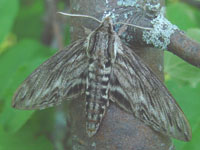
|
Sphinx canadensis
WO,
Sphinx canadensis, the Canadian Sphinx, is not common, and is not
often reported anywhere,
but it might be present in Eau Claire County.
Larval hosts are white ash (Fraxinus americana) and blueberry
(Vaccinium).
|
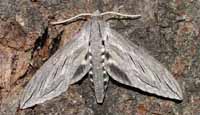 |
Sphinx chersis
WO/IM, the Northern Ash Sphinx or Great Ash Sphinx
The upperside of the forewing is soft dark gray to blue-gray
with a series of black dashes, one of which reaches the wing tip. |
Sphinx chersis, August 27-September, Ian Miller
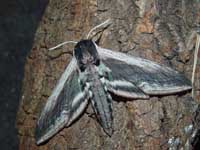 |
Forewings, long and slender, are held close to the body when the
moth is at rest. Larvae are beautiful and feed on cherry foliage.
|
Sphinx drupiferarum male, June 5, 2009, 11:45, Ian Miller
Sphinx drupiferarum male, May 21-June, 2012, Ian Miller
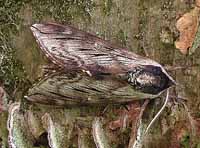 |
The upperside of the forewing ranges from brown with black borders
through brownish gray with paler borders to pale gray with no
borders. Dashes, submarginal line, and cell spot are usually weak.
|
sphinx gordius/poecila, June 16, 2012, Ian Miller
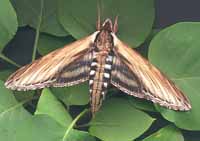 |
The lower forewings are predominantly brownish-yellow with a fairly
wide dark bar along the inner margin. At rest the wings hug the body,
giving the moth a long slender look.
|
Sphinx kalmiae, June 6, 2011, July 29-30, 2011, Ian Miller
Sphinx kalmiae, June 4-July, 2012, Ian Miller
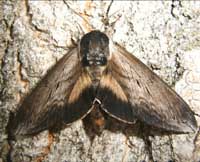 |
Sphinx luscitiosa
WO,
the Canadian Sphinx or
Clemen's Sphinx:
The fw upperside is yellowish gray in males and pale gray with
faint yellow tint in females (left). The dark border on the outer
margin widens as it approaches inner margin. Hw upperside is deep
yellow in males, pale yellow in females with wide black
border.
|
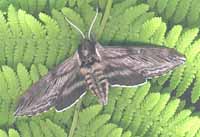 |
If you have blueberries in the woods, then you probably have the
Poecila Sphinx. They are probably widespread throughout Wisconsin,
but are very much under reported. |
sphinx gordius/poecila, June 16, 2012, Ian Miller
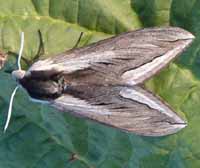 |
Sphinx vashti WO, Snowberry Sphinx:
Snowberry Sphinx adults fly as a single brood in montane woodlands and along prairie
streamcourses from April to August.
The upperside of the forewing has a narrow black subterminal line
bordered by a white inverted V-shaped line on the outside, and a
black line at the apex. |
Smerinthini Tribe:
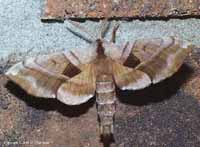 |
Amorpha juglandis
WO,
the Walnut Sphinx:
The adults are also highly variable; sometimes wings of an individual
may be all one color or may have several colors, ranging from pale to
dark brown, and may have a white or pink tinge.
See the file for the female; she is different.
|
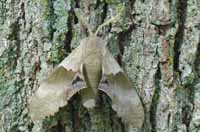 |
Pachysphinx modesta
WO/IM,
the Modest Sphinx or Poplar Sphinx,
This large poplar/willow feeder is now reported in Eau Claire County,
courtesy of Ian Miller.
They are a heavy bodied species.
|
Pachysphinx modesta, July 17-18, 2008, Ian Miller
Pachysphinx modesta female, June 6, 2009, 10:45, Ian Miller
Pachysphinx modesta male, May 11 - August, 2012, Ian Miller
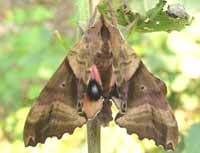 |
Paonias excaecata
WO/IM, the Blinded Sphinx:
The outer margin of the forewing is quite wavy. There is a dark cell
spot and a dark oblique line mid wing from the costa almost to the
inner margin. Basic ground colour is pinkish brown. Flight would
be June-July.
|
Paonias excaecata, July 18, 2008, July 28, 2011, June 4, 2012, Ian Miller
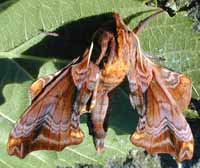 |
Paonias myops
WO/IM,
the Small-eyed Sphinx
This small species is now confirmed in Eau Claire County. This species ranges
across North America.
The hindwings have a small blue eyespot ringed with black on a yellow background.
|
Paonias myops, July 17-18, 2008, June 18, 2009, July 28, 30, 2011, Ian Miller
Paonias myops female (reared), May 24, 28, 2011, courtesy of Ian Miller.
Paonias myops, May 11-June, 2012, mid July-early August, 2012, courtesy of Ian Miller.
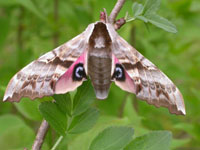 |
Smerinthus cerisyi
WO/IM, the Cerisyi's
Sphinx or One-eyed Sphinx, Larvae feed on poplars and willows.
Flight would be from late May-July as a single brood.
|
Smerinthus cerisyi male, April 26, 2012 (very early); May 4, 8, 15 - June, 2012; May 22, 26, 2014, Ian Miller
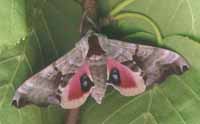 |
Smerinthus jamaicensis
WO/IM, the
Twin-spotted Sphinx:
Smerinthus jamaicensis closely resembles Smerinthus cerisyi, but
jamaicensis is much smaller with larger blue patches on more vibrant
and deeper purple in the lower wings.
|
Smerinthus jamaicensis, July 17, 2008, Ian Miller
Smerinthus jamaicensis, June 9, 2009, Ian Miller
Smerinthus jamaicensis, May 3, 2010, very early in season, Ian Miller
Smerinthus jamaicensis, May 19, 28, 2011, July 30, 2011, Ian Miller
Smerinthus jamaicensis, April 23, - June, 2012, Ian Miller
Macroglossinae subfamily
Dilophonotini Tribe:
See Hemaris comparison to help distinguish
the next three species.
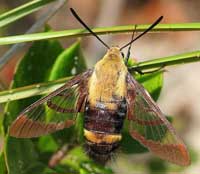 |
Hemaris diffinis
WO/IM, the Snowberry Clearwing or Bumblebee Moth,
The moth flies along forest edges and in meadows, gardens and
brushy fields. Day-flying adults nectar at lantana, dwarf bush honeysuckle,
snowberry, orange hawkweed, thistles, lilac, Canada violet, etc.
|
Hemaris diffinis larvae, August 28, 2008, Ian Miller
Hemaris diffinis, April 23 - August; 2012; May 23, 2014; Ian Miller
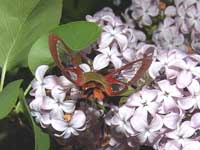 |
Hemaris gracilis
LSSS, The Slender Clearwing or Graceful
Clearwing
This day flier is not commonly reported, but it is confirmed
in the Lep. Soc. Season Summary. |
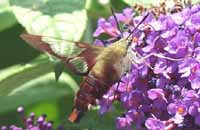 |
Hemaris thysbe
WO/IM, the Hummingbird Clearwing
It is not difficult to see why many gardeners would mistake an
Hemaris thysbe moth for a small hummingbird as it hovers, sipping
nectar from flowers through a long feeding tube.
|
Hemaris thysbe, late August, 2008, Ian Miller
Hemaris thysbe, June 4, 2009, Ian Miller
Hemaris thysbe, August 11, 2012, Ian Miller
Philampelini Tribe:
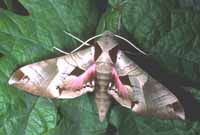 |
This moth is now confirmed for Eau Claire,
by Ian Miller.
Note the differences between this moth and the Pandorus Sphinx.
|
Eumorpha achemon, July 28-29-30, 2011, Ian Miller
"From July 25-August 8 I collected 11 male achemon sphinxes at light set ups in Eau Claire County." IM
Eumorpha achemon, July 25 - August, 2012, Ian Miller
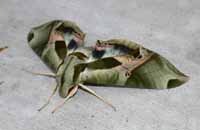 |
If you have Grape or Virginia Creeper nearby, then you might have
this species. I often get asked to identify larvae from areas where
they have not previously been reported. |
Eumorpha pandorus: Ian Miller sent me an image of a
larva he encountered while trout fishing.
Eumorpha pandorus, many eggs and first instar larvae found,
late July - early August, 2009, now mature larvae, Ian Miller
Eumorpha pandorus, July 28 male; July 29 female 11:45, male 10:45; Ian Miller
Eumorpha pandorus, June 16 - early August, 2012, Ian Miller
Macroglossini Tribe:
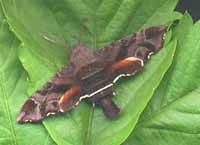 |
Amphion floridensis
WO/IM, the Nessus Sphinix:
This day flier is widely distributed. If you have Virginia Creeper,
you probably have the Nessus Sphinx. Two bright, distinct, narrow
yellow bands are often visible on the abdomen.
|
Amphion floridensis, June 2, Ian Miller
Amphion floridensis, April 23- mid June, 2012, Ian Miller
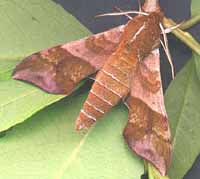 |
Darapsa choerilus WO/IM,
the Azalea Sphinx:
The lower wings of this hawkmoth are a solid brownish-orange,
matching the body colour.
You will often see this species listed as Darapsa pholus,
especially in older literature.
|
Darapsa choerilus, May 21 -early August, 2012, Ian Miller.
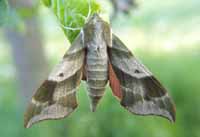 |
Darapsa myron
WO/IM, the Virginia Creeper Sphinx or the
Grapevine Sphinx:
The forewing upperside is dark brown to pale yellowish gray, with an
olive tint.
On the costal margin there is a dark rectangular patch, although
this may be reduced or absent. The upperside of the hindwing is pale
orange.
|
Darapsa myron, July 5, 2008, courtesy of Ian Miller.
Darapsa myron, May 4 - early June; mid July-August, Ian Miller
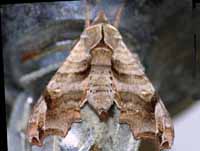 |
Deidamia inscriptum
LSSS/IM,
the Lettered Sphinx:
The moth's outer margin of the forewing is deeply scalloped.
The upperside is light brown with dark brown markings.
There is a small black and white spot near the tip.
The upperside of the hindwing is orange-brown with a dark brown
outer margin and median line.
|
Deidamia inscriptum, June 4, June 9, 2009, Ian Miller
Deidama inscriptum), May 1, May 3 (4 of them), 2010, Ian Miller
Deidamia inscriptum, May 19, 2011, Ian Miller
Deidamia inscriptum in copula, May 21, 2011, Ian Miller
Deidamia inscriptum, March 27, 2012 (very early); May 15, 2012; May 23, 2014; Ian Miller
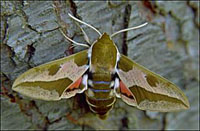 |
Hyles euphorbiae
IM, the Spurge Hawk Moth:
The body is light brown with various white and dark brown
markings, while the wings have a conspicuous tan, brown, and pink or
red color pattern.
Ian Miller, June 3, 2009.
|
Hyles euphorbiae, 10:00 pm to lights, June 3, 2009, Ian Miller.
Hyles euphorbiae two males, 10:45 pm to lights, June 9, 2009, Ian Miller.
Hyles euphorbiae male, June 18, 2009, July 29, 2011, 12:00, female; June 7, 2012, Ian Miller.
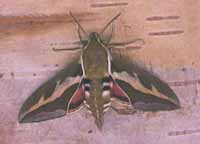 |
Hyles gallii
WO, the Bedstraw Hawk Moth
or Gallium Sphinx:
This species is not officialy reported in Eau Claire, but it has been recorded in
eastern Wisconsin counties. I suspect it is present.
Some years I see them on P.E.I., some years, I do not.
|
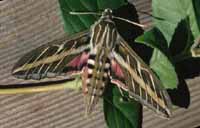 |
Hyles lineata
WO/IM, the White-lined Sphinx
Adults usually fly at dusk, during the night, and at dawn, but they
also fly during the day over a wide variety of open habitats
including deserts, suburbs, and gardens. |
Hyles lineata first instar larva and egg found on evening primrose, August 16, 2009, Ian Miller.
Hyles lineata male, July 28, 2011; May 15, 2012; Ian Miller
Hyles lineata male, June 4, August, mid September, 2012; Ian Miller
Hyles lineata female, May 26, 2014; Ian Miller
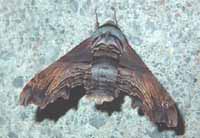 |
Sphecodina abbottii
WO/IM, the Abbott's Sphinx:
This moth is very much under reported on USGS. It is a
rapid day flier so is probably not in too many collections.
Grape is a popular larval host.
|
Sphecodina abbottii, June 4, 2008, Ian Miller
Sphecodina abbottii, June 2, 2009, Ian Miller
Sphecodina abbottii, at bait trap, May 30, 2011, May 15, 2012, Ian Miller
Sphecodina abbottii, May 11 - mid June, 2012, Ian Miller
Sphecodina abbottii, May 25, 2014, Ian Miller
|
